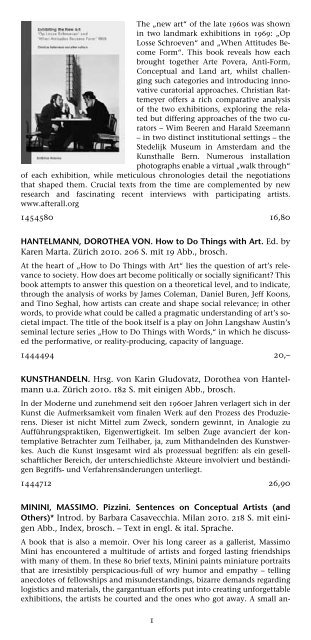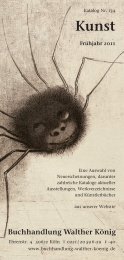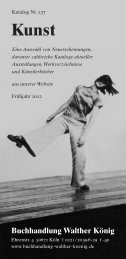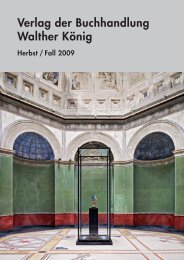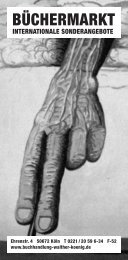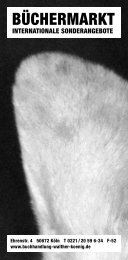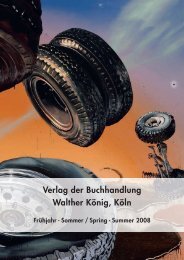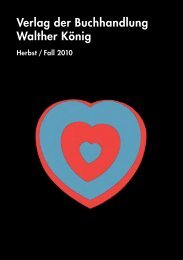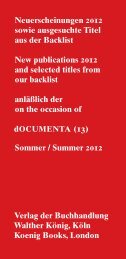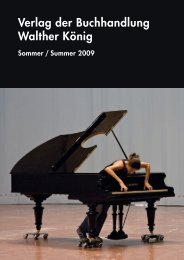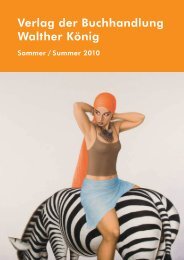Kunst - Buchhandlung Walther König
Kunst - Buchhandlung Walther König
Kunst - Buchhandlung Walther König
Erfolgreiche ePaper selbst erstellen
Machen Sie aus Ihren PDF Publikationen ein blätterbares Flipbook mit unserer einzigartigen Google optimierten e-Paper Software.
The „new art“ of the late 1960s was shown<br />
in two landmark exhibitions in 1969: „Op<br />
Losse Schroeven“ and „When Attitudes Become<br />
Form“. This book reveals how each<br />
brought together Arte Povera, Anti-Form,<br />
Conceptual and Land art, whilst challenging<br />
such categories and introducing innovative<br />
curatorial approaches. Christian Rattemeyer<br />
offers a rich comparative analysis<br />
of the two exhibitions, exploring the related<br />
but differing approaches of the two curators<br />
– Wim Beeren and Harald Szeemann<br />
– in two distinct institutional settings – the<br />
Stedelijk Museum in Amsterdam and the<br />
<strong>Kunst</strong>halle Bern. Numerous installation<br />
photographs enable a virtual „walk through“<br />
of each exhibition, while meticulous chronologies detail the negotiations<br />
that shaped them. Crucial texts from the time are complemented by new<br />
research and fascinating recent interviews with participating artists.<br />
www.after all.org<br />
1454580 16,80<br />
HANTELMANN, DOROTHEA VON. How to Do Things with Art. Ed. by<br />
Karen Marta. Zürich 2010. 206 S. mit 19 Abb., brosch.<br />
At the heart of „How to Do Things with Art“ lies the question of art’s relevance<br />
to society. How does art become politically or socially significant? This<br />
book attempts to answer this question on a theoretical level, and to indicate,<br />
through the analysis of works by James Coleman, Daniel Buren, Jeff Koons,<br />
and Tino Seghal, how artists can create and shape social relevance; in other<br />
words, to provide what could be called a pragmatic understanding of art’s societal<br />
impact. The title of the book itself is a play on John Langshaw Austin’s<br />
seminal lecture series „How to Do Things with Words,“ in which he discuss -<br />
ed the performative, or reality-producing, capacity of language.<br />
1444494 20,–<br />
KUNSTHANDELN. Hrsg. von Karin Gludovatz, Dorothea von Hantelmann<br />
u.a. Zürich 2010. 182 S. mit einigen Abb., brosch.<br />
In der Moderne und zunehmend seit den 1960er Jahren verlagert sich in der<br />
<strong>Kunst</strong> die Aufmerksamkeit vom finalen Werk auf den Prozess des Produzierens.<br />
Dieser ist nicht Mittel zum Zweck, sondern gewinnt, in Analogie zu<br />
Aufführungspraktiken, Eigenwertigkeit. Im selben Zuge avanciert der kontemplative<br />
Betrachter zum Teilhaber, ja, zum Mithandelnden des <strong>Kunst</strong>werkes.<br />
Auch die <strong>Kunst</strong> insgesamt wird als prozessual begriffen: als ein gesellschaftlicher<br />
Bereich, der unterschiedlichste Akteure involviert und beständigen<br />
Begriffs- und Verfahrensänderungen unterliegt.<br />
1444712 26,90<br />
MININI, MASSIMO. Pizzini. Sentences on Conceptual Artists (and<br />
Others)* Introd. by Barbara Casavecchia. Milan 2010. 218 S. mit einigen<br />
Abb., Index, brosch. – Text in engl. & ital. Sprache.<br />
A book that is also a memoir. Over his long career as a gallerist, Massimo<br />
Mini has encountered a multitude of artists and forged lasting friendships<br />
with many of them. In these 80 brief texts, Minini paints miniature portraits<br />
that are irresistibly perspicacious-full of wry humor and empathy – telling<br />
anecdotes of fellowships and misunderstandings, bizarre demands regarding<br />
logistics and materials, the gargantuan efforts put into creating unforgettable<br />
exhibitions, the artists he courted and the ones who got away. A small an -<br />
1


